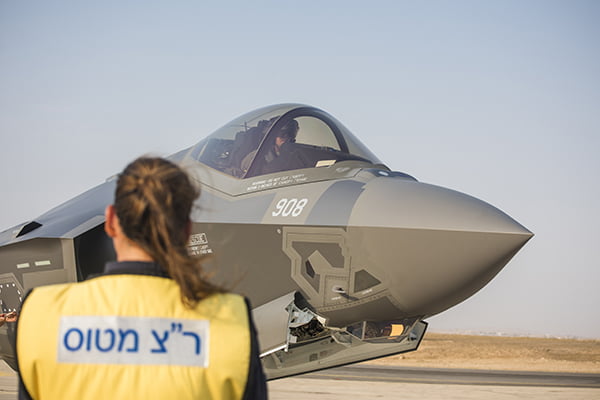2018-01-23 by Edward Timperlake
A recent piece by Yissachar Ruas published in Aviation Photography Digest on January 16, 2018 highlighted the coming of the F-35 to the Israeli Air Force.
Following a series of rigorous inspections, the Israeli Air Force’s “Golden Eagle” Squadron which flies the F-35A “Adir” Lightning 2 was declared IOC during the first week of December ‘17.
If there was any question regarding which country took delivery of the F-35 outside of the US first, following the Italians pulling a fast one on the Israeli Air Force F-35 ferry flight through Italy last year, its pretty clear which Air Force has been ramping up its F-35 activity and pressing the aircraft’s capabilities to the max.
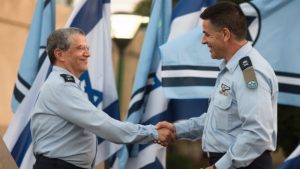
The declaration of IOC for the IAF F-35 Squadron was made by Israel’s Air Force Commander General Amikam Norkin in a letter circulated to all IAF units, this is the first step towards its growing operational use.
Having received the first 2 aircraft on December 12 2016 (SN 901 + 902), the race was on to implement and integrate as much of the F-35’s capabilities as possible.
The sense of urgency may be related to foreign reports that the Israeli Air Force is currently engaged in an ongoing aerial campaign against Iranian Revolutionary Guard forces attempting to enlarge their footprint in Syria and Lebanon….
Norkin’s predecessor Gen (ret) Amir Eshel planted the directive that the IAF is to match itself to the “Adir” not the other way around.
What exactly this entails is still highly classified. Russia’s presence in Syria may well affect how the F-35 is employed. Russian SAM radars are capable of covering most of Israeli Air Force bases and this means that Israeli non stealth platforms are probably exposed from the second they take off.
With the Russian Air Force seeking a long term presence in Syria, this could be a driving force behind acquiring additional stealth or low visibility platforms over the next decade.
The skillfulness and success of fighter pilots in aerial combat is an extensively researched yet modestly understood and fundamentally complex concept.
Innumerable physical and psychological factors along with chance opportunities affect a pilot’s facility for success in air combat.
Perhaps the best narrative of the intangibles of the skill and courage of a fighter pilot was captured by the author Tom Wolfe in his seminal work The Right Stuff.
From the first day a perspective fighter pilot begins their personal journey to become a valuated and respected member of an elite community, serving as an operational squadron pilot, the physical danger is real.
But so is the most significant force for being the absolute best that a fighter pilot can feel which is day in and day out peer pressure by those they really and truly respect, their squadron mates.
“In 1948, a group of World War II pilots volunteered to fight for Israel in the War of Independence.
“As members of ‘Machal’ — volunteers from abroad — this ragtag band of brothers not only turned the tide of the war, preventing the possible annihilation of Israel at the very moment of its birth; they also laid the groundwork for the Israeli Air Force. ABOVE AND BEYOND is their story.
“The first major feature-length documentary about the foreign airmen in the War of Independence, ABOVE AND BEYOND brings together new interviews with pilots from the ’48 War, as well as leading scholars and statesmen, including Shimon Peres, to present an extraordinary, little-known tale with reverberations up to the present day.”
http://www.imdb.com/title/tt2704752/
https://www.sldinfo.com/above-and-beyond-the-birth-of-the-israeli-air-force/
The partnership between the IAF and US combat fighter pilots is a bond that stretches from generation to generation.
A pilot featured prominently in the founding of IAF was Leon Frankel, a US Navy WWII Carrier Pilot who was awarded a Navy Cross:
His heroic efforts during World War II culminated in the sinking of the Japanese cruiser, the Yahagi.
http://militarytimes.com/citations-medals-awards/recipient.php?recipientid=19150
Another pilot discussed is Lou Lenart who was a USMC WWII F-4U Pilot.
“The Man Who Saved Tel Aviv” for his exploits fighting against a superior Egyptian force in May 1948:
“I owe so much to the United States and the Marine Corps, which gave a young Jewish immigrant sanctuary and an opportunity to excel,” he said. “This climax is beyond my wildest fantasies.”
Lenart flew an F4U Corsair in the battle of Okinawa and took part in numerous attacks on the Japanese mainland.
American and Israeli fighter pilots became very close, especially in the formative years of Top Gun.
The IAF was very generous in sharing their proven aerial battle tactics paid for in their blood, to help the US training syllabus. Top Gun, the Navy Fighter Weapons School, trained students on unique and successful tactics pioneered by the IAF — especially during the F-4 period.
Top Gun grads would then carry that knowledge out to the fleet.
The Marine counterpart to “Top Gun,” Marine Air Weapon Training Squadron or MAWTS, went as far as to purchase the Israeli Kfir fighter to use as a realistic adversary.
http://www.americanthinker.com/2009/07/f22_to_japan_and_israel_a_debt.html#ixzz551idssS8
Now two generations removed from the founders of the state of Israel, the next chapter is being written by the Squadron Pilots of the Israeli Air Force, lead in the air by their IAF Commander, and his full embrace of the F-35.
On Aug. 14, Maj. Gen. Amir Eshel resigned as IAF commander, after five years in that position.
Eshel was one of the most esteemed IAF commanders in recent decades.
He also led the process for acquiring the F-35s.
Eshel flew the jet many times and fell in love with it.
The IAF is the first force outside the United States to put F-35 jets into service.
Everyone is keeping an eye on the operational experience that the stealth jets are starting to accumulate in the Middle East.
According to a senior Israeli Air Force source, speaking on the condition of anonymity:
“It’s all concentrated on one table for us.
“As we all know, the F-35 can reach places in a way that others can’t.
“But in addition, it integrates high-level operational capabilities as well as the ability to read and analyze a battle map.
“The earlier, fourth-generation jets are excellent at maneuvering and activating sophisticated weapons systems, but they are not able to collect intelligence and independently analyze battle movement.
“The F-35 can do all this by itself in real time, with only one pilot sitting in the cockpit.
“We have never had such an operational capability until today.
“Until now, attack aircraft were operated independently of air support aircraft.
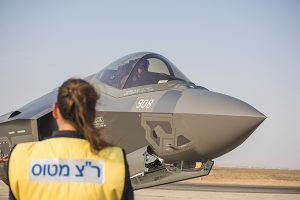
“The former waited to receive analysis of the battle picture that came from the latter.
“But in the F-35, everything is on the same platform, and this is no less than amazing.
“When you connect that to several aircraft, you receive strategic capability for the State of Israel.”
The Israeli Air Force is an elite body with first call privilege for selecting from a highly-motivated population where military service is mandatory.
A nation serious about their true life and death constant struggle for survival are very serious warriors and especially world leaders in thinking about fighting and winning in the air –always.
There is no margin for error and their technology choices for fighting can never be second class.
The take away from the article about the IAF is that the combat insight by their most experienced pilot is the total theater threat cockpit situational awareness right after takeoff.
The important point is that with the F-35, even the least experienced Squadron Pilot will also have the same intelligence in that cockpit.
An enemy cannot kill the necessary information so essential to setting up 5th gen aircraft enabled kill webs.
A stealth enabled F/A/E-35 let lose in combat by the best plots will be a huge war tipping advantage for the entire Israeli Defense Forces (IDF).
Other countries, the US included will learn a lot because of the F-35 Global Enterprise of 16 additional nations in the consortium.
Editor’s Note: In this Israeli Air Force article published on December 19, 2017, Carmel Stern and Nadav Shaham wrote about F-35 training:
In the past few months, “Adir” (F-35I) pilots have begun performing sorties in the advanced simulator established in Nevatim AFB. An instruction center for the technicians responsible for maintaining the aircraft now operates under the same roof as well.
“This instruction center is the first of its kind in the technical division. It allows us to do things we haven’t done before in training. We teach 25 different professions that have to do with the ‘Adir’ aircraft division here”, shared Maj. Tsahi Gino, Commander of the “Adir” Technician Instruction Center.
Every “Adir” (F-35I) technician is chosen for the role ahead of time, for prior knowledge of the English language, among other things. The qualification process includes a ten week-long course in the instruction center.
“The fact that we operate from an operational base contributes to the quality of our instruction. We visit the squadron every day; feel the aircraft and the connection with the squadron”, added Maj. Gino.
Paper-Free Instruction
The simulator was integrated by the IAF as part of the aircraft acquisition deal with the “Lockheed-Martin” company, which is also responsible for its maintenance.
The simulator is comprised of personal computer stations in which the aircraft’s routine maintenance work is demonstrated and explained to the technicians via various technological means. The center is also equipped with classrooms, and its personnel are currently working on establishing a unique lab to train technicians responsible for the aircraft’s ALIS (Autonomous Logistics Information System).
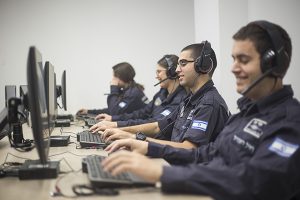
From their classrooms the technicians-in-training can hear the sounds of the HAS (Hardened Aircraft Shelter), look into the cockpit, check the fuel flow or oil in the systems, disassemble a panel or wheel and put it back.
They study technical literature with the help of advanced educational software and their instructors can see the trainees’ work from their own computers and examine their mistakes.
“Training in the simulator is completely computerized and paper-free. We are currently integrating new capabilities into the instruction center that will allow the technicians to train for additional tasks such as mounting armament.
In addition, we have already performed a pilot of a basic training program for officers from HQ, with the goal of exposing them to the ‘Adir’”, explained Master Sergeant Haim Sabah from the Material Directorate.
End-to-End Training
The center holds a number of courses simultaneously.
“The center provides end-to-end instruction. The technicians arrive when they draft and we escort them throughout their service. After completing a basic training period, they can sign off on an aircraft in their first week in the squadron”, emphasized Maj. Gino. “
Thanks to advanced simulation technology we can train the technicians with minimum interaction with the aircraft”.
Editor’s Note: An interview with the retiring COS of the IDF with Amos Harel highlighted a number of key takeaways on how the IDF was looking at the challenges and shaping a way ahead.
Major General Eshel commented:
“I don’t look at it just as a plane and capability, he explains.
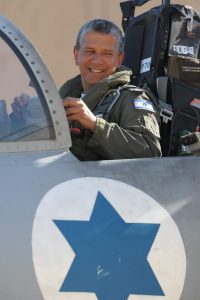 Maj. Gen. Amir Eshel in 2015. IDF Spokesperson’s Unit.
Maj. Gen. Amir Eshel in 2015. IDF Spokesperson’s Unit.
“Before the plane was received, we thought about how to change the air force and adapt it to a fifth-generation fighter, and not the opposite.
“If we had done the opposite, we would have only diminished the planes capabilities.
“You need to look at it at a system-wide level – not of the plane, of the whole air force.
“How the F-35 makes the other planes far more effective, the information it shares with them and with our information centers, how they can then do so much more thanks to that information.
“It goes far beyond the fact that it can operate in places that no other plane can”
Major General Eshel was then quoted as underscoring a unique quality of what the aircraft provides the IDF.
“When you take off in this plane from Nevatim [base], you can’t believe it.
“At 5,000 feet, the whole Middle East is there for you in the cockpit.
“You see things, its inconceivable.
“American pilots who visit us haven’t seen anything like it, because they fly over Arizona or Florida, and here they suddenly see the [entire] Middle East as a combat zone – the threats, the different players, at both close range and long range.
“Only then do you grasp the enormous potential of this machine.
“We’re already seeing it with our eyes”


